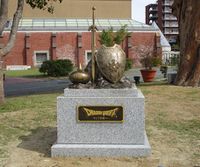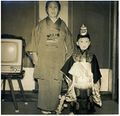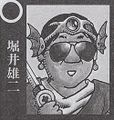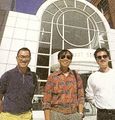Yuji Horii
Yuji Horii (堀井 雄二 Horii Yūji, also written as Yuuji Horii; born January 6, 1954 in Awaji Island, Japan) is a Japanese video game designer and scenario writer best known as the creator of the Dragon Quest series. A giant among industry veterans, he created the blueprint for the console role-playing game through his work on the Portopia series and the original Dragon Quest. He is the sole owner of the Dragon Quest series via his private company, Armor Project, which has an exclusive publishing contract with Square Enix.
Biography
Early Life
Yūji Horii was born to a family of glass artisans in Sumoto city of the Hyogo prefecture, helping in the family store during Summer. When he was young he alternated between wanting to be a manga-ka (cartoonist) or a lawyer, deciding by high school that manga was more practical than legal affairs. Horii's dedication to this career path was so great that, in his own words, he traveled to Tokyo during his third year and "barged into the office of Go Nagai and requested to be made his assistant". After being politely turned down, the young Yūji considered his options and decided to join a Manga Kenkyu-kai, a circle of manga enthusiasts, under the assumption that working a regular job and being an artist would be too difficult and that being a student would allow him to draw as much as he liked.
After graduating high school Horii applied for admittance to Waseda University in 1972, which stood out to the young man for its strong reputation as the school of humanities and social sciences of it's era. During his time at Waseda Horii would join the university's Kenkyu-kai, serving as an editor and writer for a biannual magazine called Waseda-man. During university festivals, he would help gather funds for the magazine by drawing street portraits for 50 yen. Horii would meet and befriend the late Yoshihiro Yonezawa, who would go on to create comiket, at such a festival and Waseda-man is still sold at the comic market to this day.
Due to the nation-wide students protests of 1972, as well as the murder of Daisaburo Kawaguchi, the administrative staff of Waseda effectively shut the campus down for an entire year. This abundance of free time allowed Horii to build stronger friendships with his classmates, many of whom would go on to enter the entertainment industry and hire him to write articles for their magazines. Horii would work as a professional free-lance writer during his six year stay at Waseda, producing content for a variety of avenues such as the daily newspaper Sankei Sports and Katsura Bunshi VI’s television program Itazura kamera da! Daiseiko. His focus on free-lancing was also influenced by a serious motorcycle accident in his fourth student year that severely damaged several internal organs and prohibited anything more strenuous than operating a type-writer, actively forbidding him from pursuing a more typical vocation during his six month recovery period.
Post-graduation Career
In early 1981 Horii read an article in one of the magazines he wrote for that detailed the then-upcoming rise of microcomputer systems and how they were expected to affect the daily life of the common individual. Having considered himself to be competent at mathematics and not being intimidated by the user-unfriendly campus computer at Waseda, Horii opted to purchase a model for himself.
After reaching the limits of the built-in word processing program Horii began to explore the capabilities of the machine, teaching himself BASIC as he went along. The idea of creating a game of his own dawned on Horii as he played through various bits of software that were available at the time, such as an early Nobunaga's Ambition title and a licensed Star Trek game. The most realized of these early efforts was Love Match Tennis (ラブマッチテニス), which Horii would enter into an Enix-sponsored programming contest he was reporting on in 1982. Much to his surprise, he discovered his title had placed second when he arrived to report on the awards ceremony. It was there that he met Kōichi Nakamura, whose DOOR-DOOR (ドアドア) had won first place. The two became fast friends, and decided to work together in the growing world of entertainment software.
Horii's first success at Enix was the Portopia serial murder case, a screen-by-screen adventure game that tasked the player with unraveling the mysterious circumstances of a violent murder in the eponymous seaside town. The title proved to be a watershed moment for the young Horii, garnering him well deserved respect at Enix and strengthening his working relationship with top company programmer Kōichi Nakamura. Further more, the simple menu-selection system implemented in the game would become a corner stone of the Dragon Quest series' user input.
The Road to Dragon Quest
In 1983, Enix sent Horii and Nakamura to Applefest; a trade show hosted by Apple computers in San Fransisco that allowed attendees so sample new business software, computer architecture, and computer games being developed. It was here that Horii encountered his first RPG--Wizardry. Having never encountered a game of this kind before, where success depended on strategy and thorough planning rather than quick reflexes, Horii became so enamored with the seemingly endless mysteries of the game that he purchased an Apple II immediately upon his return to Japan just to play the game.
In 1985 Portopia was ported to the Famicom, greatly improving the machine's software library from the handful of obtuse action titles. This porting success gained Horii further recognition among the gaming community, prompting him to be inaugurated in Weekly Shonen Jump's Famicom KamiKen periodical. This bi-monthly article was reflection on current hot titles, game trends, and developer gossip of the period that allowed readers to send in their own essays to be printed in Shonen Jump. When Horii sent in his own article, he was quickly hired as a staff writer. From this connection Horii would put his college education to good use and free-lance his writing skills out to various manga-ka in the magazine as he worked on his games, eventually meeting acclaimed artist Akira Toriyama at an SJ new year's party. The two became fast friends, and Toriyama would contribute character, monster, and location designs to the series.
With the success of the Famicom port of Portopia, proving that a "slow game" can dominate the sales charts in an action game market, Horii and Nakamura agreed that the timing was right to begin development of the Famicom's first genuine RPG. After a lengthy process of convincing Enix supervisor Yukinobu Chida of the project's potential for success, the unnamed project was given the greenlight to begin development with Horii as sole scenario writer, Nakamura as lead programmer, and Toriyama as illustrator. Instead of a common Wizardry clone, the two decided to combine the best aspects of both the aforementioned series and it's chief competitor Ultima and eliminate the largest design flaws of both in the process. To accomplish this it was decided to use the simple menu-driven command system of Portopia, the first-person battle screen of Wizardry, and the bird's-eye view map exploration of Ultima. Coincidentally, acclaimed composer Kōichi Sugiyama had filled out a consumer response card packaged in the back of Portopia, and was quickly approached for the possibility of composing the music for the ambitious title. Accepting the challenge, Sugiyama meets with the team and begins his composition work, even going as far as to play the scores on his piano over the phone for group approval.
After a rough development period and countless hours contemplating the feedback of Enix staff and playtesters, Dragon Quest was released on May 27th, 1986. Sales were slow at first, but strong word of mouth and a healthy advertising campaign in Shonen Jump magazine lead to a steady increase throughout the year, selling 1.5 million copies in total before production of the cartridge ceased in the early 90's. The title was an unprecedented sensation in Japan, leading to a cultural craze that lead to a boom of interest not only in RPG software, but tales of swords & sorcery, European myths and culture, and fantasy literature. For all this influence on his country's zeitgeist, Horii has remained a humble man, happy to give players new quests to venture out on as long as he can.
Approach to Design Philosophy
Cohesive, condensed conveyance of information is the cornerstone of Horii's design philosophy, a result of his experiences as an amateur manga artist. The difficulty in balancing the amount of information being presented to a reader with the limited amount of page space available was greatly influential to the man, and Horii found his experiences with such spacial limitations to be analogous to the data limits of early computer software.
Actual scenario writing is a smooth process for the man, though he admits to requiring a long time to build up motivation to begin in the first place. From a general theme and setting the finer details of a game emerge, and from that point onwards more details are added until a complete picture is formed. Prior to Dragon Quest VIII: Journey of the Cursed King, Horii would write every line of dialogue for his games, even down to nameless NPCs. This is why each title in the series feels familiar and consistent, even when separated by thirty years of hardware advancement.
Horii's views on the Series
- Favorite games: III (gameplay) and V (story narrative).
- Most profound moments in the series: Marriage and Gold Orb exchange in V, Chapter 5 opening in IV, being king for a day in Romaria in III, searching for the lost luminaries in II.
- Favorite characters: Pankraz, Bianca, Maya, Alena.
- Favorite monsters: Slime and Barbatos.
- Favorite item: Sage's stone.
- Least liked items: Kerplunk bracer, Dieamend.
- Most hated dungeons: Galen's grave in I and the Cave to Rendarak in II.
Other works
Horii wrote the scenario and served as supervisor for the Super Nintendo Entertainment System (Super Famicom in Japan) game, Chrono Trigger. Chrono Trigger had multiple game endings and Horii himself appeared in one of the endings alongside the game development staff.
He is on the selection committee for the annual Super Dash Novel Rookie of the Year Award.
Horii has visited the United States twice to promote the North American releases of Dragon Quest. He appeared at the Nintendo World Store in New York City in 2010 for the release of Dragon Quest IX: Sentinels of the Starry Skies, and again on February 12, 2011 at the Palo Alto, California GameStop for the Valenslime release of Dragon Quest VI: Realms of Revelation.
Trivia
- Horii describes himself as a mischievous man, and finds that shocking and surprising players to be one of the most rewarding parts of his career as a game designer.
- Though admittedly his skills have deteriorated since his college days, Horii draws a Slime as part of his signature when signing autographs.
- On July 15th, 2017, a bronze statue depicting a slime, alongside the sword and shield of Erdrick, was built in Sumoto city of Hyogo prefecture to celebrate Horii as one of the city's finest sons.
- In Dragon Quest VIII: Journey of the Cursed King, an infamous king slime is named Hori, presumably after Yūji Horii.
- In Dragon Quest Treasures a King Slime named after and voiced by Yuji Horii himself can be recovered by entering the code YUB. This marks the first and only time where Yuji Horii’s voice is heard in the Dragon Quest series as well as his first and only voice role in any video game.
Gallery
Yuji Horii and Final Fantasy creator, Hironobu Sakaguchi.
External Links
- Yuji Horii's personal website
- An interview conducted by current members of Waseda's Kenkyu-kai
- an archive of part 1 of the above interview

























































































